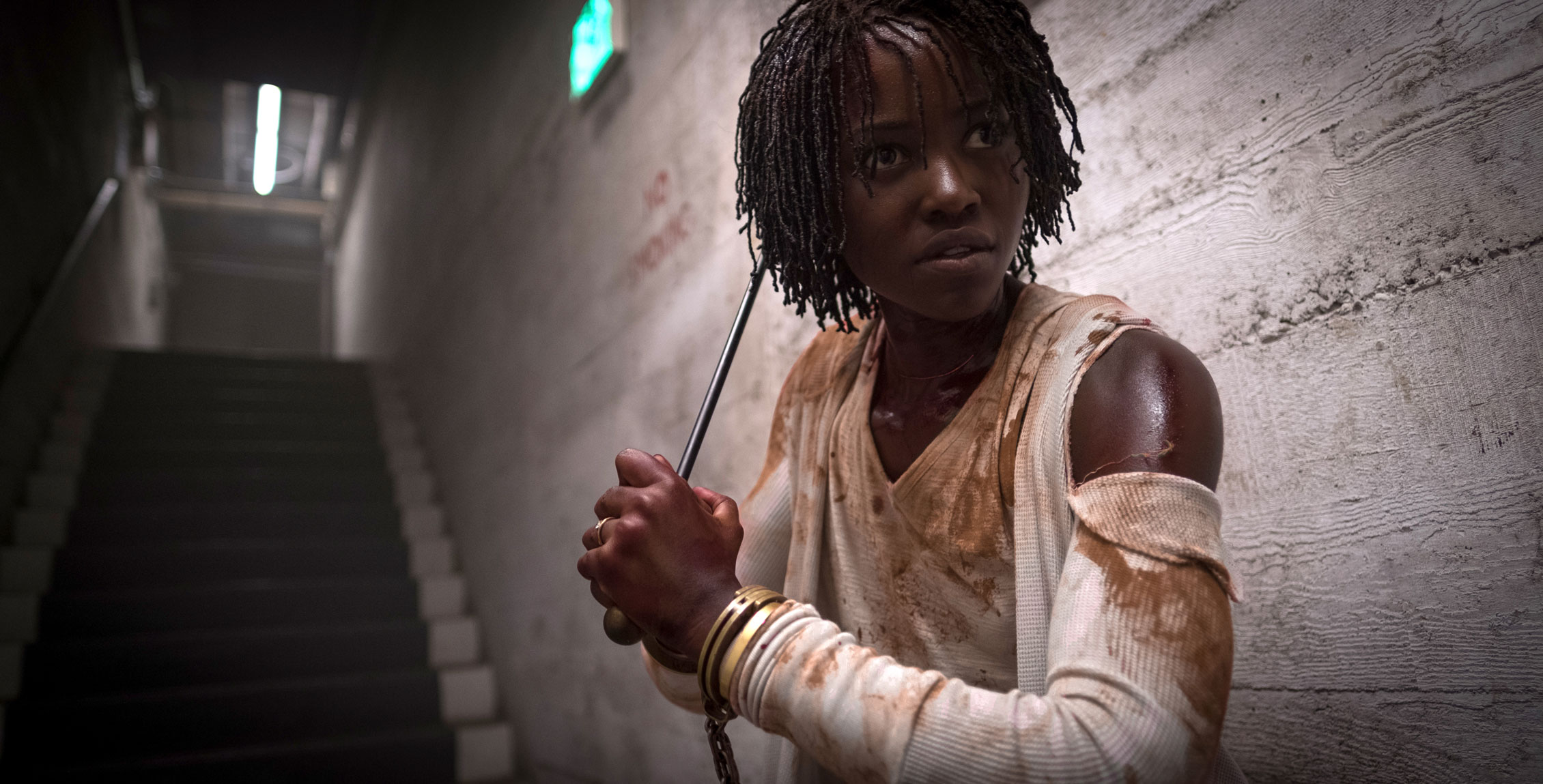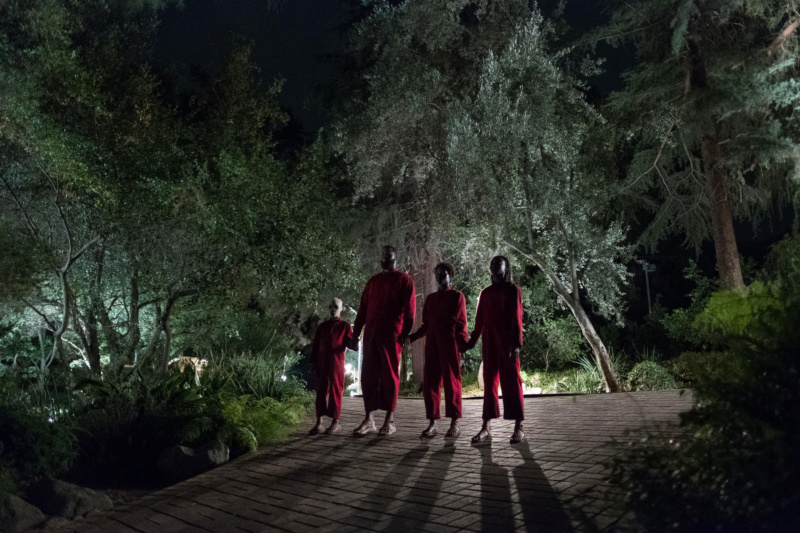
Ring ring, went fate. Artist Madeline Hollander answered. It was a call from Ian Cooper, her friend, fellow artist and director Jordan Peele’s producing partner, seeking choreographic advice on a scene for the director’s soon-to-be released thriller, Us. One year later, and Hollander is preparing for her first choreographic credit in a Hollywood blockbuster. Here, the artist answers our most burning questions, but don't worry— there are no spoilers to be found.
How did you and Jordan connect for this project? Last March, Jordan Peele’s producing partner, Ian Cooper—a friend and incredible artist—called me to discuss a particular scene in the film that involved choreography. He knows my tendency to push choreography into uncanny or creepy territories and brought up specific moments from 65 Degrees (2016) and Arena (2017), where I mess with tempo and limb reversals to distort, and then re-normalize, seemingly pedestrian moves and sequences. The more I learned about the film, the more it became clear that my background and choreographic practice aligned with this project… almost too perfectly.
My first meeting with Jordan at Monkeypaw Productions felt like we were picking up a conversation that had started a while ago—despite having just met. We immediately began working through scenes with the storyboard artist and talking through the characters’ psychological and physiological qualities and dualities. Jordan would outline a character’s attributes, history, and relationships, and then I would pitch “signature moves,” postures, gestures, and physical idiosyncrasies that aligned with his vision. It all moved very quickly and intuitively. I walked out totally invigorated and drenched in sweat.
How does working on a collaborative projects like Us differ from the performances you create for art-specific spaces? The utter scale of this production and collaboration was incomparable to anything I have ever worked on for an art space; however, the “live-ness” of set felt very similar to performing. On one level, the shoots were like epic durational performances—demanding endurance, stamina, and the ability to adapt quickly—so this part felt very familiar to me. Also, there is a telepathic type of communication that takes place on any stage, and I felt this happening throughout the entire production, both on and off set, and with the entire cast and crew. The biggest difference was probably working with a narrative script. The choreography serves to enhance a character or maintain continuity for the plotline and could never stand on its own. In my own work the script emerges last. I start with movement and use choreography as a tool to distill a concept, which is neither linear nor narrative. Roles reverse—movement becomes director, performers become crew, and the venue usually reveals the sequencing, or script.
Are you normally in for a horror movie? If so, what are your favorites? I have trouble getting through a full horror film—I saw The Exorcist when I was too young and I’m still recovering—but love when horror crosses into the world of slapstick. I actually watch them mostly for research purposes and movement inspiration. The scene where Regan crab-walks backwards down the stairwell, too fast, made a huge impression on me and iterations of that have worked their way into several choreographies. Another is when Meryl Streep “casually” and contortedly emerges in heels and with her head on backwards after falling down the stairs in Death Becomes Her—this became a great warm-up exercise. Or the mangled physicality of Edgar, played by Vincent D’Onofrio, in Men in Black after an alien steals his skin. I like the feeling when your body can’t register whether something is comedic or horrific— you end up laughing at the grotesque and cringing at the slapstick. It becomes visceral.
One of my favorite “horror” details from Get Out is what I call the “constant-speed” running. I couldn’t figure out why I was so freaked out by the running scenes, which are relatively benign in comparison to the rest of the film, and then realized it was the characters’ uneasy steadiness—never speeding up or slowing down, and with a fixed gaze. Running full speed without any acceleration or de-acceleration is still the scariest thing I can think of right now—it’s the ultimate contemporary zombie move.

In your mind, does horror have a distinct sense of timing or rhythm? For me, horror invites tampering with everyday speeds, directions, and patterns. Catastrophe moves too slow, limbs move too fast and automatic reflexes are off...wrong. But it’s subtle. Slight physical shifts that might be imperceptible—for example, having an actor stand with their feet slightly too far apart or too close together—can significantly alter the energy of a character or scene.
To me, the timing of Us aligns more with the rhythms and logic of a nightmare than a typical horror film. The story is embedded with so many meta-layers of detail, double meaning and subversion, and resonates with realities both within and outside of the film. There is a lot to unpack. It’s a real contemporary nightmare. Is that a film genre yet?
I know you aren’t allowed to disclose any spoilers, but what was the most challenging part of working on this project? The most challenging part of the production for me were the shoots that required coordinating and choreographing large groups of extras—and then upholding the continuity of each sequence when resetting and repeating for multiple POVs. I’m used to working with small groups, usually between 2- 20 bodies, and having weeks or months of rehearsal to prepare, so navigating this scale and immediacy was entirely new for me. I had to come up with new techniques for communicating physical instruction, movement flow, and cues across distances and just delegation in general.
I ended up singling out several extras that I knew had dance backgrounds to become “leaders”—essentially creating an impromptu team of undercover movement assistants who would each be responsible for guiding their own group through the trajectories the given scene. This was a huge revelation, because it meant I could pre-rehearse the scene with my team off-set, and then let them relay the instructions and lead their extras during the shoots. I still ended up sprinting constantly around set and lost my voice daily, but it was a huge help!
Would you want to work on more films in the future? Yes, I’m hooked. Working on Us felt like a beginning and I miss the electricity of that level of collaboration. I see so much potential for incorporating choreography, movement direction, and corporeal vocabularies into film, and finding new ways to use movement to tell a story. It was inspiring to witness how Jordan utilizes narrative and genre to slyly frame critical subject matter and push the limits of the medium—it would be an honor to work with him again.
Do you think the work you did for Us will reflect back in your fine art practice? Yes, and hopefully the influence goes both ways!
Right now I am completely fascinated by stunt coordination and its relationship to choreography, sleight-of-hand, and movement economies. I feel very lucky to have been able to work with Mark Vanselow, the stunt coordinator for Us and his Action Horizons team, and to be exposed to this new repertoire of movements and rules. Vanselow would setup the overarching stunt and then I would go in and tweak it to make sure the moves or postures matched up with the integrity of the characters’ profile. I’ve always found it jarring, and distracting, when an actor suddenly transforms from a klutz into a pro-samurai fighter, so I got to make sure this never happened. Coincidentally, for the last few years I have been developing a new movement vocabulary I call “future slapstick,” so the experience of working on this production fed directly into this research—the timing was uncanny.




